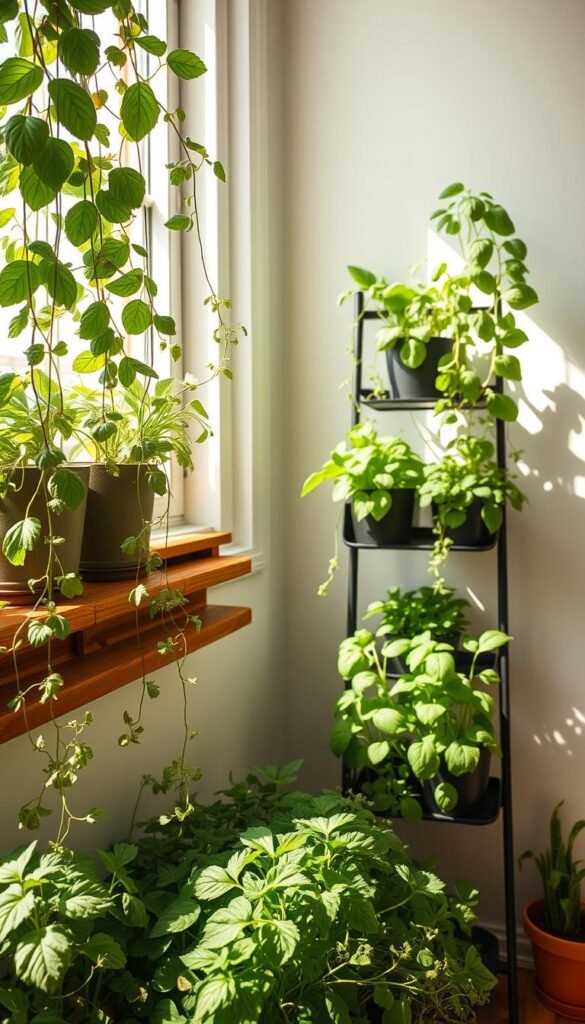Living in a city doesn’t mean sacrificing fresh flavors at mealtime. One Brooklyn resident proved this by turning a dim studio into a lush oasis using vertical shelves and LED lights. Their story shows how creative solutions can overcome tight quarters and low natural light.
You don’t need a backyard to enjoy homegrown ingredients. With smart planning, even awkward nooks become productive spaces. A 48-inch alcove might hold basil and mint thriving under strategic grow lights, while windowsills support leafy greens. The rewards go beyond taste—think lower grocery bills and a lighter environmental footprint.
This guide shares practical steps for cultivating your own sustainable supply. Learn to assess your layout, choose compact systems, and harvest faster than you’d expect. Whether you’re new to plants or refining your skills, these methods work in real homes.
Fresh food at your fingertips isn’t just a dream. Start small, and watch your living area transform into a vibrant source of nourishment and pride.
Designing Your Space for Maximum Growth
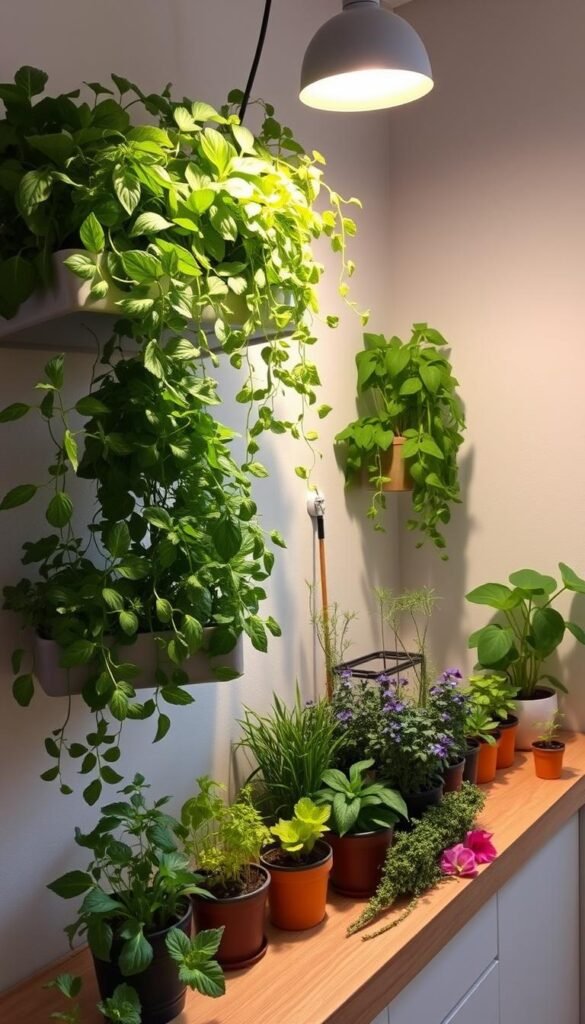
Your home’s layout holds hidden potential for fresh flavors. Start by mapping sunlight patterns across rooms. Watch how rays hit surfaces at 9 AM versus 3 PM—this reveals your brightest spots.
Light Mapping Made Simple
South-facing glass areas work best for sun-loving varieties like rosemary. North-facing spots suit mint or parsley that thrive in softer light. One New Yorker transformed a narrow 48-inch alcove using three-tier shelves, rotating pots to catch morning and afternoon rays.
Smart Storage Solutions
Stackable planters turn blank walls into thriving zones. Opt for containers with drainage trays—they prevent messes while letting roots breathe. Container gardening hacks show how repurposed shoe organizers can host basil clusters.
Shelves should adjust as your plants stretch upward. Metal racks handle heavy soil better than plastic. Keep taller greens on lower levels to avoid top-heavy setups. Measure twice: leave 6 inches between lights and leaves to prevent scorching.
“Vertical systems doubled my harvest without crowding the room,” shares a Brooklyn gardener using wall-mounted pockets.
Test layouts with empty boxes before committing. You’ll spot traffic flow issues early. Remember: your setup should simplify care, not complicate daily life.
Essential Tools and Materials for Your Indoor Garden
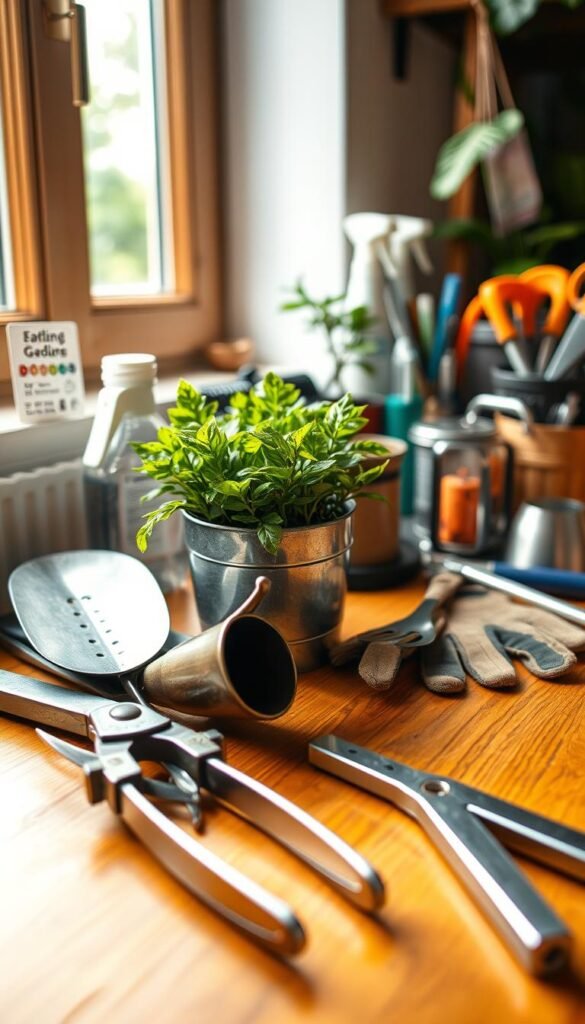
The right toolkit turns cramped quarters into productive spaces. Let’s explore the building blocks for thriving plants—from root-supporting blends to precision watering gear.
Selecting Soil, Compost, and Coconut Coir
Your mix determines success. Blend equal parts organic potting soil (like Happy Frog), compost, and coconut coir. This trio balances nutrition and drainage. One urban gardener boosted yields using 12 cubic feet of this combination in Brute 14-gallon bins.
Coconut coir works magic. These shredded husk blocks expand 5x when soaked, creating airy texture. They prevent soggy roots better than peat moss. Store leftovers in sealed bags to maintain moisture.
Choosing the Right Grow Lights and Watering Tools
LED panels outperform traditional bulbs. Look for full-spectrum options with adjustable heights. Set timers for 15 daily hours—mimicking summer days. “My basil doubled in size after switching to programmable LEDs,” reports a Chicago plant enthusiast.
Water wisely. Use cans with narrow spouts to target soil without splashing leaves. Pair containers with deep saucers—they catch runoff while letting roots breathe. Test moisture with your finger before watering again.
Indoor Food Garden: Grow Edible Greens and Herbs in Small Apartments
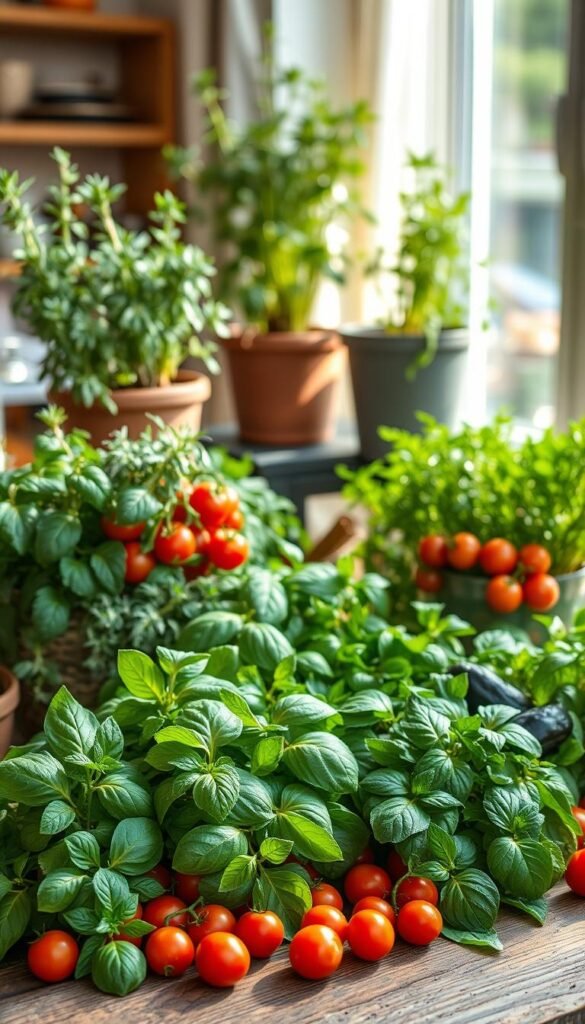
Your kitchen counter holds more potential than you think. Basil and parsley lead the charge among herbs that flourish in limited spaces, their fragrant leaves ready to upgrade sandwiches and sauces. Pair them with cilantro for tacos or thyme for roasted veggies—these culinary staples demand just 4-6 hours of light daily.
Leafy greens like baby kale and spinach deliver quick rewards. Try ‘cut-and-come-again’ types—snip outer leaves, and new growth appears within days. One Chicago gardener shares:
“My windowsill lettuce mix provides salad fixings year-round. I harvest 3 ounces weekly from just six plants.”
Dwarf vegetable varieties pack big flavor into small packages. Cherry tomatoes burst with sweetness in 12-inch pots, while radishes mature in 25 days. Start with seeds labeled ‘patio’ or ‘container’ for guaranteed compact growth.
Don’t overlook microgreens. These nutrient powerhouses go from seed to plate in 10 days flat. Grow peppery arugula sprouts or sunflower shoots in shallow trays—perfect for renters needing quick wins.
Mix perennial herbs like rosemary into your lineup. Their woody stems thrive for years with minimal care. Rotate new plants every 2-3 weeks using succession planting for nonstop harvests. Before long, you’ll garnish meals with homegrown pride.
Optimizing Light, Water, and Nutrient Strategies
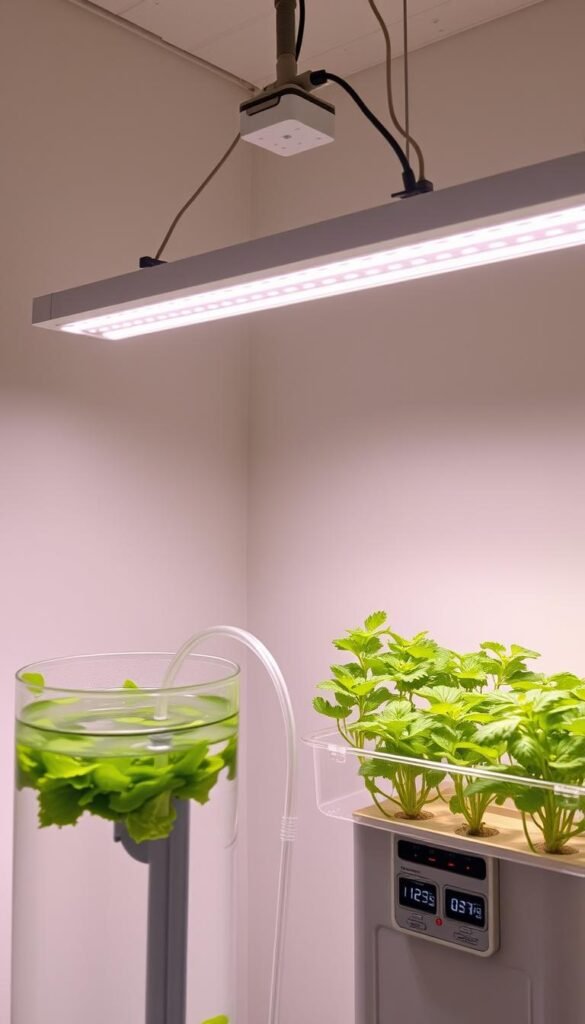
Mastering the balance between light and hydration transforms your growing results. Proper timing and positioning turn modest setups into powerhouse producers. Let’s break down how to align these elements for thriving greenery.
Maximizing Natural Light and Supplementing with LED Options
Sun exposure determines your lighting game plan. Track how sunlight moves across your space using free apps like Lux Light Meter. South-facing windows deliver 6-8 bright hours daily—ideal for basil and cherry tomatoes. North-facing areas? Pair natural rays with LED panels for 14-16 total hours.
- Seedlings: 16-18 hours under lights
- Leafy greens: 12-14 hours combined light
- Fruiting plants: 14-20 hours daily
Position LEDs 3-6 inches above sprouts, lifting as plants mature. “My kale grows 30% faster since adjusting lights weekly,” notes a Seattle urban gardener. Full-spectrum bulbs work best—they mimic natural conditions without overheating leaves.
Scheduling Watering and Feeding for Consistent Growth
Check soil moisture daily—if the top inch feels dry, it’s time to hydrate. Use room-temperature water to avoid shocking roots. Pair this routine with liquid fertilizers every 3 weeks during active growth phases.
“I mark feeding days on my calendar app—consistency prevents nutrient crashes,” shares a Miami microgreen grower.
Create a simple schedule:
- Morning: Check soil
- Evening: Water if needed
- Weekends: Fertilize (alternate weeks)
LED timers automate light cycles, freeing you to focus on plant health. Remember: overwatering drowns roots faster than underwatering. Adjust as seasons change—plants drink less in winter.
Creative Tips for a Bountiful Indoor Harvest
Innovative layouts can triple your yield without expanding your footprint. Start by reimagining unused areas—walls, corners, and even ceilings become prime real estate when approached creatively.
Reach New Heights With Vertical Solutions
Pocket planters transform blank walls into living tapestries of fresh herbs. Try mounting felt systems near windows for basil or thyme—their leaves stay within easy reach for cooking. One urban grower reported doubling mint production using this method.
Stackable containers let you grow upward, not outward. Opt for modular designs with built-in drainage. Rotate pots weekly so all plants get equal light exposure. A tiered strawberry tower in Chicago proves even fruit thrives this way.
For tight quarters, use hanging baskets. Suspend them near light sources using adjustable hooks. This frees counter space while giving trailing varieties like oregano room to cascade. Pair these tips with weekly pruning to encourage bushier growth.
Remember: success lies in adaptability. Test arrangements seasonally, and watch your garden flourish beyond expectations.

